Amethyst Woodstar Hummingbird: A Comprehensive Guide
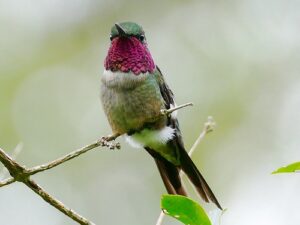
The world of hummingbirds is filled with vibrant colors and fascinating creatures, but few can match the allure of the Amethyst Woodstar. This tiny marvel, scientifically known as Calliphlox amethystina, is a true gem among South American birds. In this comprehensive guide, we’ll explore the captivating world of the Amethyst Woodstar hummingbird, delving into its unique characteristics, habitat, behavior, and the conservation efforts surrounding this species.
Introduction
Imagine a bird so small it could perch comfortably on the tip of your finger, yet so vibrant it seems to glow with an otherworldly light. This is the Amethyst Woodstar hummingbird, one of the smallest members of the hummingbird family. Despite its diminutive size, this species has captured the hearts of birdwatchers and nature enthusiasts across the globe.
Found exclusively in South America, the Amethyst Woodstar is a testament to nature’s ability to create beauty on the tiniest scale. Its name comes from the male’s striking throat feathers, which shimmer with an intense purple hue reminiscent of the precious amethyst gemstone. However, there’s much more to this species than its dazzling appearance.
In the following sections, we’ll take a closer look at what makes the Amethyst Woodstar truly special. From its physical characteristics to its behavior and conservation status, we’ll uncover the secrets of this remarkable hummingbird. So, let’s spread our wings and dive into the wonderful world of the Amethyst Woodstar!
Characteristics and Identification
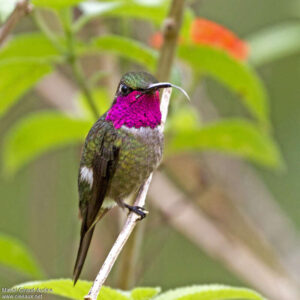
Physical Description
When it comes to size, the Amethyst Woodstar is truly a miniature marvel. Measuring between 6 to 8.4 cm (2.4 to 3.3 inches) in length, it’s one of the smallest hummingbirds in existence. To put this into perspective, it’s about the size of a large bumblebee! Furthermore, these tiny birds are incredibly lightweight, tipping the scales at a mere 2.5 to 3.2 grams – that’s less than the weight of a penny!
Despite their small size, Amethyst Woodstars are big on visual impact. The males, in particular, are a sight to behold. Their most striking feature is undoubtedly the iridescent amethyst-colored throat patch, known as a gorget. This brilliant purple hue shimmers and changes color depending on the angle of light, creating a mesmerizing display that’s hard to miss.
In contrast, female Amethyst Woodstars sport a more subdued palette. Their underparts are primarily whitish, dotted with green spots that provide excellent camouflage among the foliage. This difference in appearance between males and females, known as sexual dimorphism, is common among hummingbird species and serves various ecological and behavioral purposes.
Another distinguishing feature of the Amethyst Woodstar is its tail. Males possess a deeply forked tail, which adds to their distinctive silhouette when perched or in flight. Females, on the other hand, have a shorter, less dramatic tail shape. This difference not only aids in identification but also plays a role in the species’ courtship displays and flight mechanics.
The beak of the Amethyst Woodstar is another noteworthy feature. Like all hummingbirds, it has a long, slender bill perfectly adapted for probing deep into flowers to reach the nectar. This specialized feeding apparatus is a prime example of how evolution has shaped these birds to fill a specific ecological niche.
Habitat and Distribution
Now that we’ve painted a picture of what the Amethyst Woodstar looks like, let’s explore where in the world you might encounter this tiny dynamo. The Amethyst Woodstar calls South America home, but its range is quite extensive within the continent.
You can find these hummingbirds flitting about in a variety of countries, including Colombia, Ecuador, Peru, Venezuela, Bolivia, Brazil, Argentina, Guyana, Suriname, French Guiana, and Paraguay. Interestingly, they’re absent from Chile and Uruguay, which highlights the specific environmental conditions they require to thrive.
Within these countries, Amethyst Woodstars show a preference for semi-open landscapes. They’re not typically found in dense, closed-canopy forests. Instead, they favor forest edges, savannas, and scrubby woodlands. These habitats provide the perfect balance of open space for flight and foraging, along with enough vegetation for shelter and nesting.
The versatility of the Amethyst Woodstar is evident in its ability to adapt to various elevations. You might spot these birds from sea level up to altitudes of around 2,600 meters (8,530 feet) in some parts of their range. This adaptability allows them to occupy a wide variety of ecological niches across their extensive distribution.
It’s worth noting that the habitat preferences of the Amethyst Woodstar play a crucial role in its conservation. As human activities continue to alter landscapes across South America, the availability of suitable habitats for these birds becomes an increasingly important consideration for their long-term survival.
Behavior and Diet
Feeding Habits
Like all hummingbirds, the Amethyst Woodstar is a nectar specialist. These tiny birds have evolved to feed primarily on the sweet nectar of flowering plants, which provides them with the high-energy fuel they need to power their incredibly fast metabolisms. Their long, specialized beaks allow them to reach deep into flowers, while their tube-like tongues efficiently draw up the nectar.
However, it’s a common misconception that hummingbirds feed exclusively on nectar. In fact, the Amethyst Woodstar, like its relatives, also incorporates a significant amount of small insects and spiders into its diet. These protein-rich food sources are especially important during the breeding season when the birds need extra nutrients to support egg production and chick rearing.
The feeding behavior of the Amethyst Woodstar is a marvel to observe. These birds can hover in place with incredible precision, their wings beating so fast they’re almost invisible to the naked eye. This unique ability allows them to feed from flowers that other birds can’t access, giving them a competitive edge in their ecosystem.
Interestingly, Amethyst Woodstars don’t just passively accept whatever nectar is available. They’ve been observed to have preferences for certain types of flowers, often favoring those with tubular shapes that match their long beaks. This selective feeding behavior can have important implications for plant pollination in their habitats.
The Amethyst Woodstar (Calliphlox amethystina/Estrelinha-ametista) is a species of hummingbird in the family Trochilidae. It is found in most of central, and eastern South America proper, in Argentina, Bolivia, Brazil, Colombia, Ecuador, French Guiana, Guyana, Suriname-(the Guianas), Paraguay, Peru, and Venezuela.
Breeding and Nesting
The breeding season for Amethyst Woodstars typically runs from November to April in eastern Brazil, though this can vary slightly across their range. During this time, these normally solitary birds engage in fascinating courtship rituals.
Male Amethyst Woodstars put on quite a show to attract females. They perform elaborate aerial displays, showcasing their iridescent throat patches and deeply forked tails. These displays often involve rapid ascents followed by steep, J-shaped dives, accompanied by unique vocalizations. It’s a spectacular sight that demonstrates the agility and beauty of these tiny birds.
Once a pair has formed, it’s the female who takes on the bulk of the nesting responsibilities. She constructs a tiny, cup-shaped nest using an assortment of plant fibers, often bound together with spider silk. This elastic material allows the nest to expand as the chicks grow. The outside of the nest is typically camouflaged with bits of lichen or moss, making it incredibly difficult to spot.
The female usually lays two tiny eggs, each about the size of a coffee bean. She incubates these eggs for about 15-16 days, only leaving the nest for short periods to feed. Once the chicks hatch, they’re completely helpless, with closed eyes and no feathers. The mother feeds them a diet of regurgitated insects and nectar, and they grow rapidly. In just about 20-25 days, the young Amethyst Woodstars are ready to leave the nest and start their independent lives.
This rapid development from egg to fledgling is crucial for the survival of the species. The small size of Amethyst Woodstars makes them vulnerable to a wide range of predators, so the quicker they can grow and become self-sufficient, the better their chances of survival.
Conservation Status
While the Amethyst Woodstar is not currently listed as a threatened species by major conservation bodies like the IUCN, this doesn’t mean the species is free from challenges. Like many wildlife species, the primary threat facing Amethyst Woodstars is habitat loss and degradation.
As human populations expand across South America, natural habitats are being converted for agriculture, urban development, and other human uses. This can lead to the loss of the semi-open woodlands and forest edges that Amethyst Woodstars rely on for feeding and nesting. Additionally, climate change poses a potential threat, as it could alter the distribution of the flowering plants these birds depend on for food.
Conservation efforts for the Amethyst Woodstar are largely focused on habitat preservation. By protecting and maintaining the open woodlands and savannas where these birds thrive, we can help ensure their continued survival. This not only benefits the Amethyst Woodstar but also a wide range of other species that share its habitat.
Many conservation organizations are working to establish protected areas and promote sustainable land use practices in regions where Amethyst Woodstars are found. These efforts often involve working with local communities to find ways of meeting human needs while also preserving critical wildlife habitats.
Another important aspect of conservation for the Amethyst Woodstar involves research and monitoring. By studying these birds and tracking their populations, scientists can better understand their needs and detect any concerning trends early on. This knowledge is crucial for developing effective conservation strategies.
Individuals can also play a role in helping Amethyst Woodstars and other hummingbird species. If you live within their range, you can create hummingbird-friendly gardens by planting native flowering plants. Even if you’re not in South America, supporting conservation organizations that work in the region can make a difference.
Fascinating Facts About the Amethyst Woodstar
To truly appreciate the wonder of the Amethyst Woodstar, let’s explore some fascinating facts about these remarkable birds:
-
Incredible Speed: Despite their tiny size, Amethyst Woodstars are capable of flying at speeds of up to 30 miles per hour. During courtship dives, they may reach even higher speeds!
-
Rapid Heartbeat: The heart of an Amethyst Woodstar beats at an astonishing rate of about 1,200 times per minute when in flight. To put this in perspective, the human heart typically beats 60-100 times per minute at rest.
-
Unique Sleep State: Like other hummingbirds, Amethyst Woodstars enter a state of torpor at night to conserve energy. Their body temperature drops, and their metabolic rate slows dramatically.
-
Backwards Flight: Amethyst Woodstars can fly backwards, a feat that very few birds can accomplish. This ability allows them to maneuver with incredible precision while feeding.
-
Iridescent Feathers: The stunning purple color of the male’s throat isn’t caused by pigment, but by the structure of the feathers themselves. These feathers refract light like prisms, creating the shimmering effect we see.
-
Exceptional Memory: Despite their tiny brains, Amethyst Woodstars have excellent memories. They can remember the locations of good feeding sites and return to them year after year.
-
Constant Eating: Due to their high metabolism, Amethyst Woodstars need to eat frequently. They may visit hundreds of flowers in a single day to get enough nectar.
Frequently Asked Questions
What is the typical lifespan of an Amethyst Woodstar?
While specific data on the lifespan of Amethyst Woodstars in the wild is limited, hummingbirds generally live for about 3 to 5 years. However, some individuals have been known to live longer, up to 10 years or more, especially in protected environments. Factors such as predation, disease, and environmental conditions can all impact a bird’s lifespan.
How do Amethyst Woodstars protect their territories?
Male Amethyst Woodstars are known for their aggressive territorial behavior. They vigorously defend their feeding territories against other males and even larger insects like bees or butterflies. This defense often involves high-speed chases and aerial displays. The iridescent throat patch of the male likely plays a role in these territorial disputes, serving as a signal of the bird’s fitness and willingness to defend its resources.
Can Amethyst Woodstars be kept as pets?
No, Amethyst Woodstars, like all wild hummingbirds, should not be kept as pets. These birds have highly specialized needs that are extremely difficult to meet in captivity. Moreover, in many countries, it’s illegal to capture or keep wild hummingbirds. The best way to enjoy these beautiful creatures is to observe them in their natural habitat or create a hummingbird-friendly garden if you live within their range.
How do Amethyst Woodstars contribute to their ecosystem?
Amethyst Woodstars play a crucial role in their ecosystems as pollinators. As they feed on nectar, they transfer pollen from flower to flower, aiding in plant reproduction. Some plants have even evolved alongside hummingbirds, developing tubular flowers that are perfectly suited to hummingbird beaks. By helping to maintain plant diversity, Amethyst Woodstars contribute to the overall health and balance of their habitats.
Conclusion
The Amethyst Woodstar hummingbird is truly a marvel of nature. From its tiny size and dazzling plumage to its incredible flying abilities and important ecological role, this species embodies the wonder and complexity of the natural world. As we’ve explored in this guide, these diminutive birds are far more than just a pretty sight – they’re integral components of their ecosystems and fascinating subjects of scientific study.
However, like many species, the Amethyst Woodstar faces challenges in our rapidly changing world. While not currently threatened, the preservation of its habitat is crucial for ensuring that future generations can continue to marvel at these iridescent jewels of the sky. By understanding and appreciating species like the Amethyst Woodstar, we can foster a greater connection with nature and inspire efforts to protect the incredible biodiversity of our planet.
Whether you’re a seasoned birdwatcher, a nature enthusiast, or simply someone who appreciates the wonders of the natural world, the Amethyst Woodstar offers a glimpse into the extraordinary diversity and beauty of life on Earth. So next time you find yourself in the forests and savannas of South America, keep an eye out for that tiny flash of purple – you might just be lucky enough to spot an Amethyst Woodstar hummingbird!
One of the best Hummingbird feeders that’s easy to take apart and clean is the HummZinger Ultra.
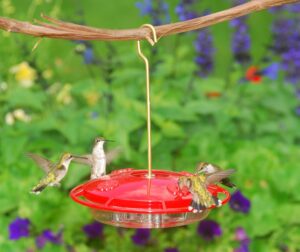
Aspects 12oz HummZinger Ultra With Nectar Guard.
The HummZinger Ultra 12oz Saucer Feeder is one of the best options for a hummingbird feeder that’s both easy to clean and maintain. This top-tier feeder features patented Nectar Guard tips—flexible membranes on the feeding ports that keep flying insects out while still allowing hummingbirds to feed freely. Plus, it comes with an integrated ant moat to prevent crawling insects from reaching the nectar, and the raised flower ports help divert rain, keeping the nectar fresh.
With a 12 oz capacity, this mid-size feeder offers plenty of space and can be hung or mounted on a post using the included hardware. It has four feeding ports and is made from durable, unbreakable polycarbonate. Whether you’re concerned about bees, wasps, or ants, this feeder is built for easy cleaning and insect protection.
If you already have a hummingbird feeder, and you want to protect it from ants and other crawling insects, the ant moat below will do the job.
Trap-It Ant Moat for Hummingbird Feeders
Using an ant moat for your hummingbird feeder is an effective way to keep ants away from the sweet nectar. These tiny creatures are drawn to
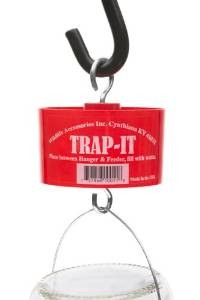
the sugar water, and without a barrier, they will quickly infest your feeder, preventing the birds from enjoying the nectar. An ant moat works by creating a barrier of water that ants can’t cross. Positioned above the feeder, it effectively blocks the ants’ path, keeping them from reaching the nectar.
This simple solution also ensures that your hummingbird feeder remains clean and accessible for the birds, rather than becoming a breeding ground for ants or other pests. It’s a small addition that can make a big difference in maintaining a healthy, inviting space for hummingbirds, while also reducing the need for chemical ant deterrents.
The first and still the best to protect your Hummingbird and Oriole feeder from ants and other crawling insects. Insert between hanger and feeder and fill with water, providing a barrier to crawling pests. Red color to attract hummingbirds.
| Small bottle brushes and pipe cleaners are always helpful to dislodge mold inside the feeder and in the feeding ports. It is necessary to have a clean mold free feeder to attract hummingbirds and to keep them healthy. |
Window feeder for a close up viewing area
Experience the thrill of watching hummingbirds up close as they hover right outside your window. With a hummingbird window feeder!
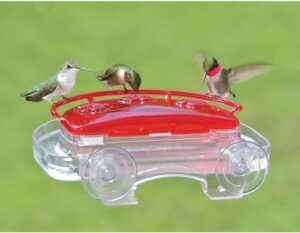
Having a hummingbird window feeder brings the excitement of nature right to your window. Imagine watching these vibrant, tiny birds hover just inches away as they sip nectar. Their iridescent feathers glisten in the light, and their rapid wing beats create a mesmerizing display you can enjoy from the comfort of your home. It’s a truly unique and personal experience, offering a front-row seat to nature’s most agile acrobats.
What makes a hummingbird window feeder even more thrilling is how often these fascinating creatures visit. You’ll get to see them return throughout the day, sometimes making multiple stops at your feeder. Each visit is a new opportunity to observe their graceful movements and learn more about these incredible birds. It’s like having your own live wildlife show right outside your window!
Beyond the joy of bird watching, a hummingbird window feeder adds a burst of color and life to your space. Whether you’re relaxing indoors or enjoying a cup of coffee, the sight of these dazzling creatures brings a touch of serenity and beauty to your day. It’s a simple, yet unforgettable way to connect with nature without leaving home.
If you found this article helpful please share it with your friends using the social bookmarking buttons on the left side of this page. Help everyone to increase their enjoyment of feeding hummingbirds. Do it for the hummingbirds!
Hummingbird Resources to help you enjoy hummingbirds
Here’s a complete guide to attracting hummingbirds to your yard. It lists plants, vines and shrubs that are in bloom for spring, summer and fall. Your hummingbirds will always have flowers to feed on.
Here’s a great article that tells everything you need to know about how to choose the best place to hang your hummingbird feeder.
Here’s the best designed hummingbird feeder to use. It’s leak proof, so it won’t attract insects and it’s easy to take apart and clean.
Here’s a comprehensive guide to help you clean your hummingbird feederfor those times when the nectar is not changed soon enough and mold starts to grow.


